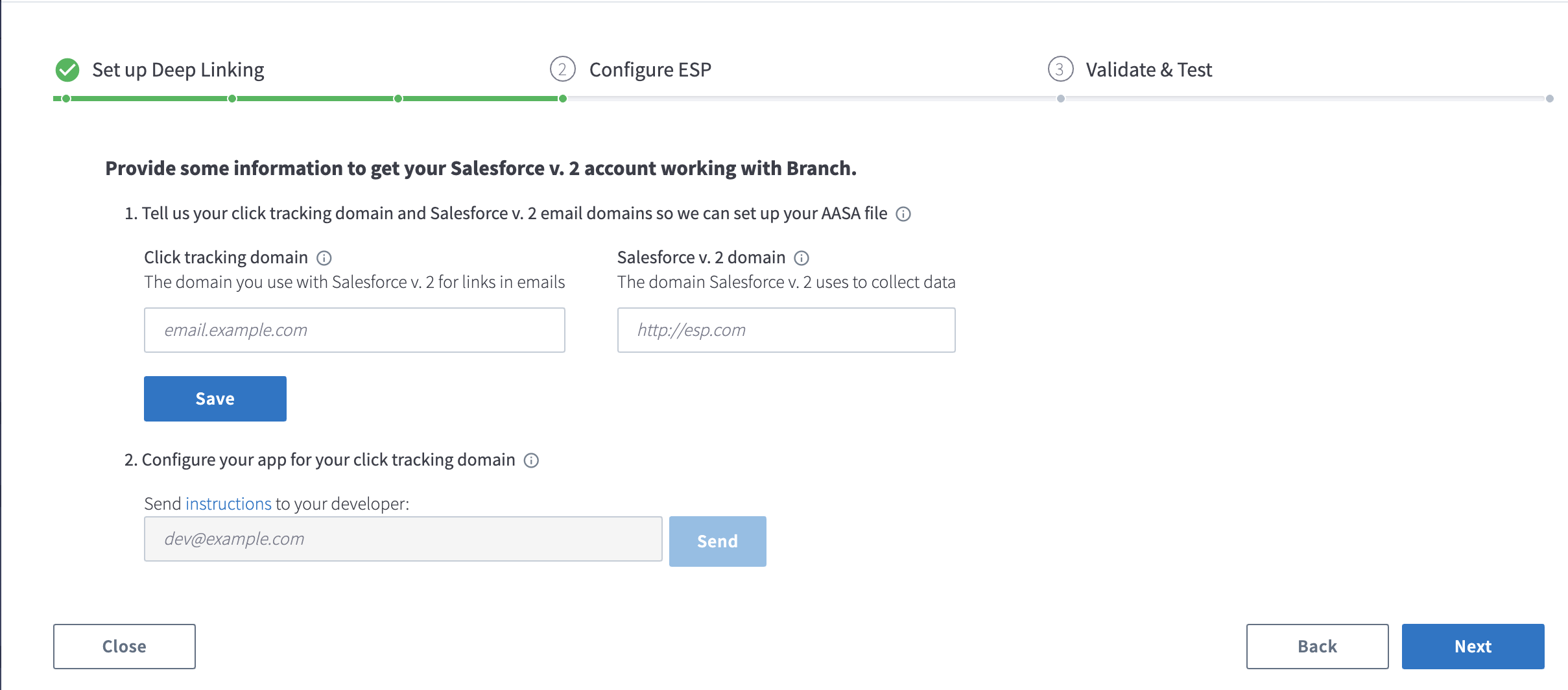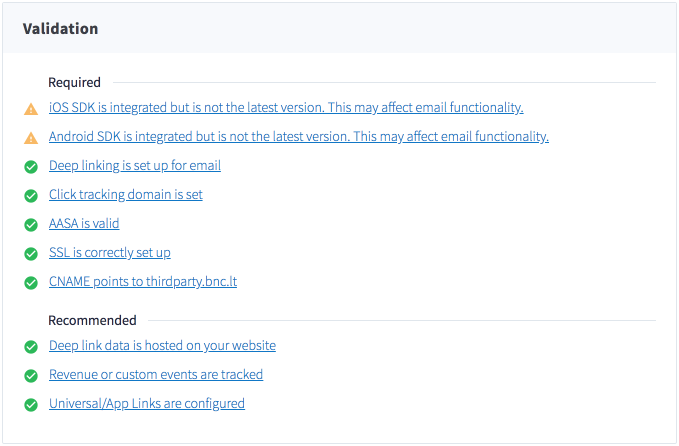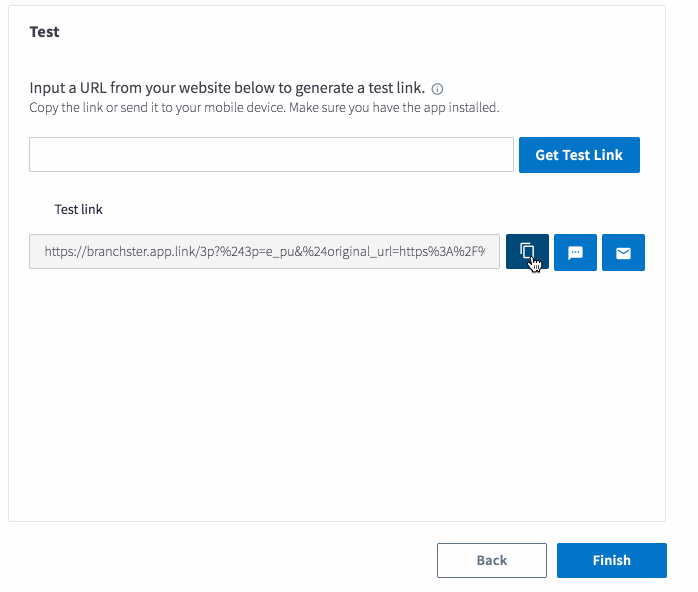Salesforce v3 Legacy
Overview

Meet Email Studio. Reach your customers with the world’s #1 email marketing platform. Build smarter email — from basic marketing campaigns to sophisticated 1-to-1 messages.
1. Complete Universal Email Prerequisites
DEVELOPER MAY BE REQUIRED
The following Universal Email prerequisite includes providing URI schemes and other components that may require a developer:
DEVELOPER REQUIRED
The following Universal Email prerequisites involve app code changes:
2. Configure Salesforce
Setup a Sender Authentication Package
-
Configure the Sender Authentication Package for your Salesforce Marketing Cloud account using instructions form your Salesforce account manger.

For more information on how to set up your domain, please visit Salesforce Marketing Cloud's documentation.
Updating DNS settings
As soon as you've configured and verified the Sender Authentication Package with the Salesforce team, please find the click record in your DNS settings so we can update your DNS settings.
3. Enable the Integration
To enable the integration:
- In the left-hand navigation, click Email.
- On the Email overview page, click the Manager tab at the top.
- Find your ESP and click Enable.

Branch automatically detects any global link settings you have already provided during the initial setup of your Branch account as outlined above.
If you have not set up your global link settings and redirect preferences, you will be prompted to do so at this time.
4. Provide Click Tracking Domain
Click tracking domains allow you to track engagement on email opens and link clicks.
If you're unsure what your click tracking domain (CTD) is, take a look at one of your recently sent emails. If you hover over the link or right-click/copy the link address, you will see that the domain of the link in the email does not match the URL in your HTML. This domain is your click tracking domain used by your ESP to provide you click reporting.
The Salesforce v2 integration requires you provide the following:
- Click Tracking Domain - The domain you use with Salesforce for links in emails
- Salesforce Domain - The domain Salesforce uses to collect data
Remove
http://orhttps://when adding your click tracking domain in the Branch dashboard

KEEP IN MIND
- You can enable the integration with multiple CTD if needed, but you cannot add the same CTD to multiple Branch dashboards or ESP integrations.
Before you click NEXT and proceed to the Validate & Test section, please complete the following section as it’s required for passing integration validation.
5. Validate the Integration
Once the SSL certificates and AASA file (iOS only) have been generated, you can proceed to reviewing the validation tests, fix any issues and then test the integration.
Branch automatically validates the following:
- iOS SDK is integrated (required)
- Android SDK is integrated (required)
- Deep linking is setup (required)
- Click Tracking Domain is setup (required)
- AASA file is valid (required)
- SSL is correctly setup (required)
- CNAME points to thirdparty.bnc.lt (case-by-case requirement)
- Universal Linking is setup (required)
- Hosted deep link data (optional)
- App Events being tracked (optional)
- Android App Links (optional)

Common Validation Issues
CNAME Does Not Point to Branch
As this integration requires the CNAME to point to Salesforce, you will always get this error. You can safely ignore.
SSL Not Correctly Set Up
If you are having issues with the SSL certificate validating, the culprit is generally the fact that your click tracking domain already has SSL set up and there are restrictions that prevent a 3rd party from submitting a Certificate Signing Request on your behalf.
AASA File is Invalid
Luckily the easiest issue to fix as the main reason for this error is the fact that it depends on the SSL being set up correctly. By addressing the SSL error, the AASA file error should resolve itself simultaneously.
6. Test the Integration
Once the validation process is complete, you can test the integration by generating a test link. The test link generated by Branch is unique in that it’s already converted to a Branch link for you and allows you to test without creating an email template in your ESP. In reality, this conversion happens behind the scenes once a user clicks on your normal email template link.
To generate a test link:
- In the Validate & Test section, input a URL from your website.
- Click Get Test Link.
- Once the Test Link is generated, you can share it via:
- Copy to clipboard
- SMS

Once you’ve generated your test link, click the link on your mobile device; don’t forget to make sure your mobile device already has the app installed!
7. Start Sending Emails with Flagged Links
Congratulations, you’ve successfully set up the integration with Salesforce!
Before you start setting up your email campaigns, you need to determine what flow you want the user to experience and flag your email link accordingly.
Flag your deep links
For the email links that you would like to deep link to content, add mc-deep-link="false" to HTML and $deep_link=true to the URL as a query parameter, for example:
<a mc-deep-link="false" href="links.example.com?$deep_link=true" >Link to your app!</a>
This will ensure that your links are converted to Branch links that will open the app on iOS and Android, with full tracking and attribution.


